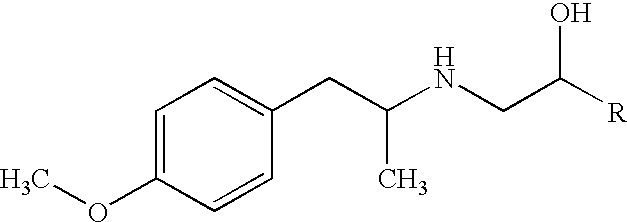Pharmaceutical formulations for dry powder inhalers in the form of hard-pellets
a technology of dry powder and inhaler, which is applied in the direction of aerosol delivery, peptide/protein ingredients, and metabolic disorders, etc., can solve the problems of poor inhalation technique, reduced drug amount which penetrates the bronchial tree, and increased oropharyngeal deposition to the detriment of the patient, so as to avoid any potential mechanical stress and simple mixing
- Summary
- Abstract
- Description
- Claims
- Application Information
AI Technical Summary
Benefits of technology
Problems solved by technology
Method used
Image
Examples
example 2
Hard-Pellet Formulation Containing Coarse Lactose (CapsuLac 212-355 μm), a Micronized Pre-blend Lactose / Magnesium Stearate Mixture Obtained by Ball Milling and Formoterol Fumarate as Active Ingredient
[0104]Blend A was prepared as described in the Example 1 but using α-lactose monohydrate SorboLac 400 with a starting particle size below 30 μm (d(v, 0.5) of about 10 μm) and carrying out the co-micronisation in a ball milling apparatus for 2 hours.
[0105]Blend B was prepared according to the Example 1 but after mixing for 6 mins and then screening through a 355 μm sieve.
[0106]The hard pellet final formulation was prepared according to the Example 1.
[0107]The particle size distribution, the water contact angle and the degree of coating for the micronized mixture (blend A), and the uniformity of distribution of the active ingredient for the final formulation (blend B), determined as previously described, are reported in Table 4.
[0108]Analogous results were achieved after preparing blend B...
example 3
Determination of the Suitable Amount of Magnesium Stearate to be Added in the Formulation
[0113]Samples of pre-blends were prepared as described in Example 2 in a ball milling apparatus for 2 hours using α-Lactose monohydrate SorboLac 400 (Meggle microtose) with a starting particle size below 30 μm (d(v, 0.5) of about 10 μm) and magnesium stearate with a starting particle size of 3 to 35 μm (d(v, 0.5) of about 10 μm) in the ratio 98:2, 95:5 and 90:10 percent by weight (blends A).
[0114]Blends B and the hard pellet final formulation were prepared as previously described; the amount of magnesium stearate in the final formulations turns out to be 0.3, 0.75 and 1.5 percent by weight, respectively. The uniformity of distribution of active ingredient and the in-vitro aerosol performance were determined as previously described. The results obtained are reported in Table 6.
[0115]
TABLE 6Uniformity of distribution and in-vitro aerosol performancesMg stearateMg stearateMg stearate0.3%0.75%1.5%Co...
example 4
Ordered Mixtures Powder Formulations
[0117]Powders mixtures were prepared by mixing of commercially available α-lactose monohydrate with different particle size and formoterol fumarate to obtain a ratio of 12 μg of active to 20 mg of carrier. Blending was carried out in glass mortar for 30 mins. The uniformity of distribution of active ingredient and the in-vitro aerosol performances were determined as previously described. The results are reported In Table 7.
[0118]
TABLE 7Uniformity of distribution and in-vitro aerosol performancesSpherolacSpherolacPharmatose100100Spherolac 100325 M(63-90 μm)(90-150 μm)(150-250 μm)(30-100 μm)ContentuniformityMean μg)11.8911.8112.9811.90RSD (%)3.882.179.0310.10Shot weightMean (mg)25.2825.2322.0222.40RSD (%)7.733.396.9322.00Emitted dose11.1010.308.507.80(μg)FPD (μg)1.400.700.601.20FPF (%)12.66.87.115.4
[0119]The results indicate that, upon preparation of ordered mixtures containing formoterol fumarate as active ingredient according to the teaching of th...
PUM
| Property | Measurement | Unit |
|---|---|---|
| mean particle size | aaaaa | aaaaa |
| particle size | aaaaa | aaaaa |
| particle size | aaaaa | aaaaa |
Abstract
Description
Claims
Application Information
 Login to View More
Login to View More - R&D
- Intellectual Property
- Life Sciences
- Materials
- Tech Scout
- Unparalleled Data Quality
- Higher Quality Content
- 60% Fewer Hallucinations
Browse by: Latest US Patents, China's latest patents, Technical Efficacy Thesaurus, Application Domain, Technology Topic, Popular Technical Reports.
© 2025 PatSnap. All rights reserved.Legal|Privacy policy|Modern Slavery Act Transparency Statement|Sitemap|About US| Contact US: help@patsnap.com


